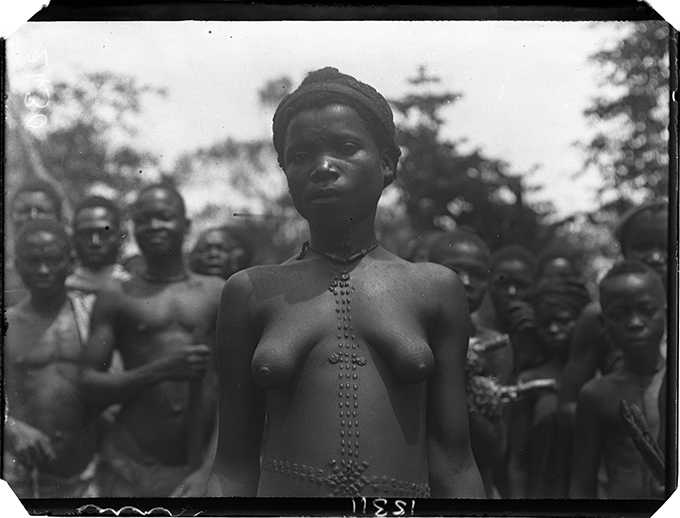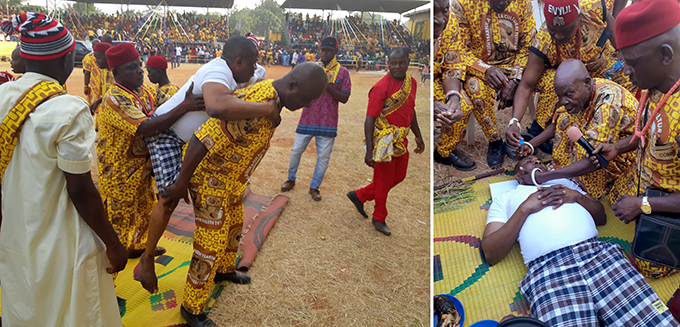by George Emeka Agbo, Chijioke Onuora and Paul Basu

On 31 December 2018, the pavilion of the Umudioka Arts and Cultural Centre in Neni, Anambra State, Nigeria was filled by thousands of people who attended the 40th Nka Dioka Cultural Festival of Umudioka, Neni. Ndi Igwe (community leaders), titled men, and state functionaries graced the occasion. A live orchestra, cultural musical troupes (such as Egedege), and masquerades (agbogho mmonwu, otenkwu, etc.) electrified the arena with their performances. The people of Umudioka filed in in groups according to their age grades, all dressed in the same uniform designed exclusively for the occasion. The main motif repeated on this uniform comprised of a man’s face with ichi marks positioned above the tools used for the scarification, framed with the inscription ‘40th Year Nka Dioka Cultural Festival of Umudioka Community Neni’. The motif is a visual articulation of the event, giving insight into the history and culture of this town in Anambra State.

Umudioka communities (in Neni and seven other towns among the Igbo) were historically known as specialist surgeons who carried out ichi and nki facial scarification, mbubu (body marking from neck to belly) and iwa eze (tooth filing). Among the photographs that Northcote Thomas made during his 1910-11 anthropological survey of what was then Awka District (corresponding more or less with present-day Anambra State), there are numerous portraits of people with facial and body scarification. Due to its broad social, political, and economic signification, ichi was the most common of these markings. Ichi specialists from Umudioka were invited to various towns across the region to create the marks on those who wanted them. Their clients were mainly male, although certain women, including priestesses, could also obtain the marks. Thomas wrote about the practice in his Anthropological Report on the Ibo-speaking Peoples of Nigeria.


In the case of families of high social and economic status,ichi marks could be obtained for their children at a relatively early age. In adulthood one can also do it as an expression of one’s wealth and prestige. The ichi scarification process begins with a journey by the Nwadioka (ichi specialist from Umudioka) to the Nwa Ichi (his client). The Nwadioka is accompanied by Nwa Nso, an assistant who carries the the Nwadioka’s tool bag and prepares the ground (mat and wooden pillow) on which the Nwa Ichi lies for the marking. He is also accompanied by the Nwa Mgbado Ichi, a second assistant who holds down the Nwa Ichi’s legs on the mat while the scarification is taking place. It is, of course, painful to receive ichi marks; so, to assuage the pain during the procedure, the Nwa Ichi’s mother or wife intermittently gives him a piece of fish to eat. Words of encouragement and melodious songs are also used to soothe the pain. At the same time, the lyrics of the songs convey various messages about ichi, the dexterity and experiences of the Nwadioka, and the value of the art. Nwa Nso plays the role of a nurse for fourteen days, cleaning the cuts with warm water and administering herbs that facilitates the healing.


Before the incursion of Christian missionary activity, ichi served as a means of protection for those who had the marks. For instance, they were not prone to abduction for slavery which was rampant at that time. The high value placed on ichi also made it a prerequisite for ozo title taking in most Igbo communities. In fact, ichi is seen as a sign of class stratification, not only by virtue of receiving the marks, but by the Nwa Ichi’s ability to ‘hire’ the costly implements used to make the marks. There are two types of ichi knives which do not necessarily produce different results but the use of one attracts higher payment than the other. Thus, there is an ichi knife for the highly affluent and another for the average class. When the Nwadioka completes the ichi cutting, he remits a certain percentage of his pay to the group of retired Nwadioka called Ndi Isimmanka.
In the mid-twentieth century, the ichi marking tradition was disrupted by the expansion of Christianity, which held that it was a fetishistic practice. Following the consequential decline, and after much controversy, the ichi tradition was, however, reinvented in Neni in 1978. From then on, ichi marks would no longer be received in the actual sense of cutting the skin, rather it became a symbolic practice performed annually at the Nka Dioka Cultural Festival. We witnessed this reinvented tradition being performed at the 40th anniversary of Nka Dioka in Neni on 31 December 2018. Two men received the symbolic marks that day. Then men were carried on the backs of attendants and laid on mats where the ceremony took place. The marking ceremony was accompanied by the traditional ichi songs and the Nwa Ichi were given fish to eat as in the original ceremony. The marking itself, however, did not involve cutting; rather the ichi knife merely traced the patterns on the men’s foreheads, leaving no visible trace.

Northcote Thomas was not the only ethnographer to make a study of ichi scarification among the Igbo people. The anthropologically-minded missionary, George Basden, who spent most of his career working in the Awka/Onitsha area from 1900 to 1926, discussed ichi scarification in his 1921 book Among the Ibos of Nigeria. In particular, Basden noted the important role of Umudioka (which he spelled Umu-di-awka) communities in the practice. He observed that the men of Umudioka ‘hold a sort of monopoly of the profession [of ichi cutting], and travel all over the country for the purpose’; further noting that ‘judging by the number of those bearing the ichi marks, it must be a prosperous business’ (1921: 183).
It was, however, a later Government Anthropologist, M. D. W. Jeffreys, who made a more extensive investigation of facial scarification as part of a study of ‘the magico-religious beliefs of the Umundri’. Jeffreys identified two distinct ichi patterns, one associated exclusively with Ndri, another which he termed the ‘Agbaja Pattern’. In his article, ‘The Winged Solar Disk of Ibo Itchi Facial Scarification’, published in 1951, Jeffreys provides a detailed account of ichi from a man named Nwora from Nibo, who was an old man when interviewed in 1930, when he recalled having the ichi operation in his youth. Nwora explained that the Eze Nri had told the Umudioka to cut other towns differently to Nri, and it is forbidden to use the Nri pattern elsewhere.

Ichi patterns were not only cut into people’s forheads. The same patterns are used to decorate a wide range of objects, including wooden door panels, ancestral figures, stools, masks and pottery used for ritual purposes. Thomas photographed many such objects during his survey work, and we have also come across examples in the artefact collections he made, which are cared for by the University of Cambridge Museum of Archaeology and Anthropology. We will be including a section on ichi in the [Re:]Entanglements exhibition in 2020 when we will display some of these objects alongside contemporary artwork by Chijioke Onuora, who is developing a series of batik paintings drawing on ichi motifs documented in Northcote Thomas’s photographs and collections.


As can be seen in the Nka Dioka Cultural Festival in Neni, ichi is celebrated as an important part of Igbo cultural heritage – especially among Umudioka communities. In this respect it is interesting to note how Chief Odidika Chidolue (also known as Oke Iwe Adimma) is revered by the community as the only surviving man in Neni who has actual ichi marks. As a valued part of Neni’s living heritage, he receives a monthly stipend of 15,000 Naira from the Eyisi Ebuluo Foundation, which supports the preservation of local culture. In the course of our fieldwork we had the privilege of talking with Chief Odidika Chidolue as well as Nze R. O. Udeze (Eyisi Ebulue II) and Fidelis Igwilo, and were fortunate in being able to record some of their traditional ichi songs.

We look forward to continuing our research in Neni and, through the [Re:]Entanglements project, exploring other opportunities for documenting this fascinating cultural heritage for the benefit of future generations.
References
Basden, G. T. (1921) Among the Ibos of Nigeria. London: Seeley, Service & Co.
Jeffreys, M. D. W. (1951) ‘The Winged Solar Disk or Ibo Itchi Facial Scarification’, Africa 21(2): 93-111.
Thomas, N. W. (1913) Anthropological Report on the Ibo-speaking Peoples of Nigeria, Part I: Law and Custom of the Ibo of the Awka Neighbourhood, S. Nigeria. London: Harrison & Sons.